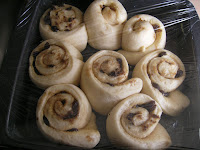(From River Cottage Bread Handbook by Daniel Stevens)
Makes 24-28 croissants
1 kg strong white bread flour, plus extra for dusting
20 g salt
330 ml warm water
330 ml warm milk
10g powdered dried yeast (instant/bread machine yeast)
140g caster sugar/white sugar
500g unsalted butter
For glaze
2 medium egg yolks
50ml milk
It is best to use a food mixer for the first stage as the dough will be soft, sticky and difficult to knead by hand. So, put all the ingredients, except the butter, into the mixer bowl and fit the dough hook. Knead on low to medium speed until the dough is soft, stretchy and satiny – about 10 minutes. Put the dough in a decent sized polythene bag (it needs room to rise), suck out the air, tie a knot in the bag and put it in the fridge to rest over night.
First thing in the morning, get the butter out of he fridge. You need it to warm up a bit so it is workable, but not soft. The idea is that the dough and the butter have a similar degree of firmness.
As soon as it seems ready, lightly flour the butter, lay it between two sheets of cling film and bat it out with a rolling pin to a fairly neat square about 1cm thick. Take your time to get the thickness and shape as even as possible, then put it to one side.
Take your dough out of the fridge, flour it and roll out to a rectangle, a little more than twice the size of the butter (allow a couple of centimeters extra all around). Now lay the butter on one half leaving a border, fold the other half over and press down all the way round to seal the butter in.
Next roll the dough away from you until it is twice its original length, then fold the top and bottom edges in by one sixth. Fold them in again by another sixth, so the folds meet in the middle, then fold one on top of the other.
Give the dough a quarter turn and roll it out again to about the same size as before, fold the top and bottom edges in to meet at the middle, then fold one on top of the other. Roll this out slightly and seal the edges with the rolling pin.
Put the dough back in the plastic bag and return it to the fridge to rest for an hour or so. (You’ve given the gluten a good workout and it must relax now, otherwise it will be resistant and uncooperative later.)
*I found the dough extremely resistant after a 2 hour rest and I had to use a Herculean effort to roll it out. I did halve the dough and let the second half rest overnight and had a much easier time rolling it out. Unless you’re a body builder I would advise a longer rest than an hour or two.
In the meantime, you need to cut a template from a piece of cardboard (the back of a cereal box or something similar). You want an isosceles triangle, measuring 20cm across the base and 25cm tall. (The easiest way is to draw an upside down capital T and join the points, like a cartoon sail).
When your dough has rested, unwrap and roll it out to a neat rectangle, a little larger than 140cm x 50cm (pic 1). Now trim the rectangle to these measurements leaving perfectly straight edges. Cut the rectangle in two lengthwise, to give two 25cm wide strips. Now using your template as a guide, cute 12-14 triangles from each strip(pic 2).
Lay each triangle away from you and roll it up from the base (pic 3). Wet the pointed end and seal it. Curl the tips around to form a crescent and pinch them together to hold them in place (pic 4); or you can leave them straight if you prefer. (At this point you could freeze some if you like. Space them out on a tray and freeze, then pack into bags. Allow an extra hour for rising when you come to use them).
Lay your croissants with the sealed point underneath, on baking trays lined with greased baking parchment or (better still) silicone mats. Cover with cling film or a bin liner and leave to rise until doubled in side. As the dough is cold, this could take a couple of hours, or longer.
When ready to bake, preheat the oven to 200C/400F /Gas Mark 6. Beat the egg yolk and the milk together, then gently brush all over the croissants. Bake for about 10 minutes, then lower the setting to 170C/325F/Gas Mark 3 and bake for further 10-15 minutes until they look beautifully golden. Transfer to a wire rack and let cool slightly, while you make coffee.
P.S. If your work surface isn’t large enough to roll the dough out to a 140 x 50cm rectangle, cut it in half. Roll out one portion at a time to a rectangle a little bigger than 70 x 50cm, then cut the strips as above and cut 6 or 7 triangles from each strip, using your template as a guide.
Variations
You can make larger criossants by using a larger template. I put a square of chocolate inside the criosant when rolling up the pasrty for a decadent treat.
For savoury treat I put a small amount of grated cheese and some small pieces of cooked bacon inside the criossants when rolling them up.
Here are some of the plain criossants that I made:
























